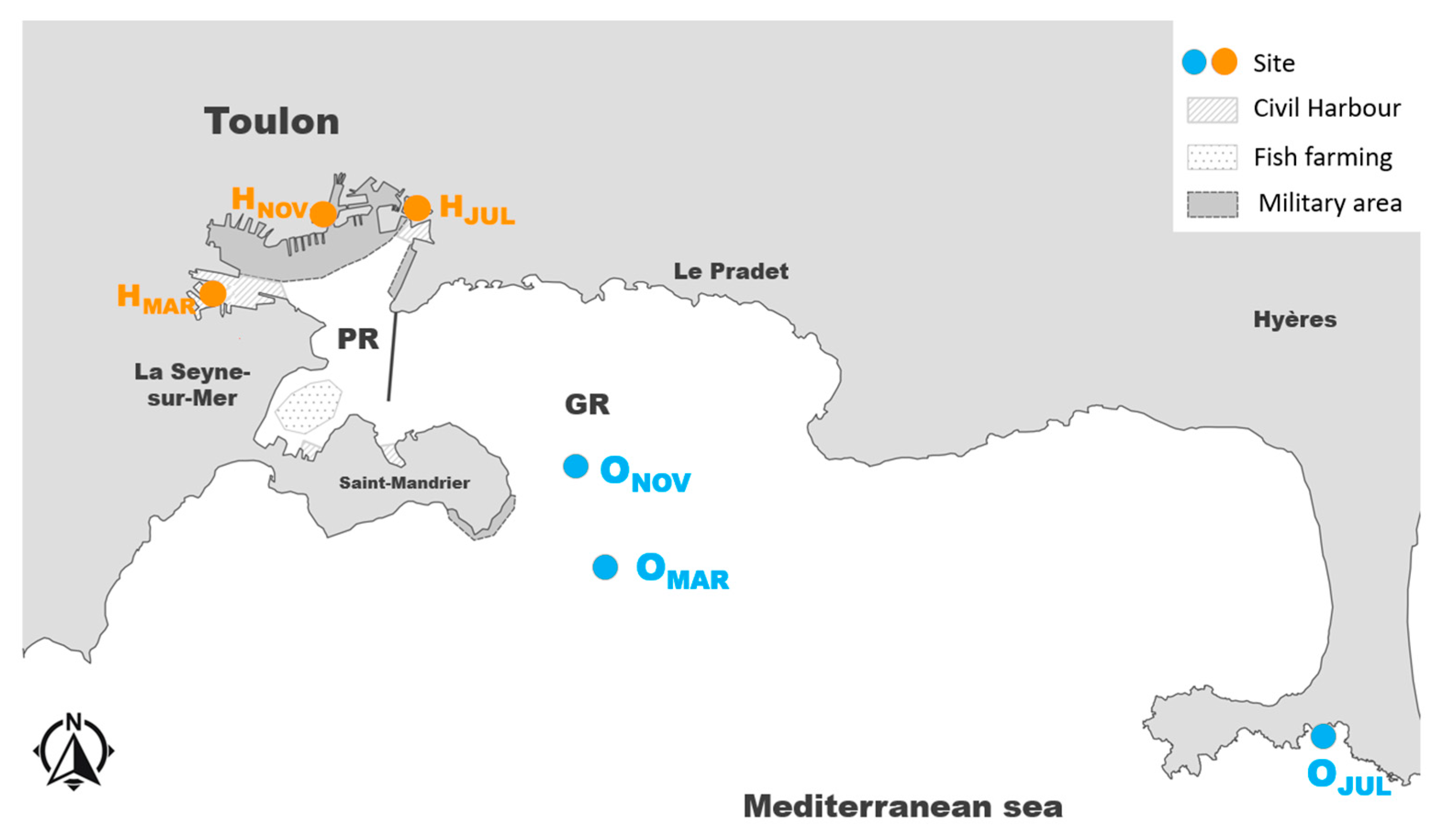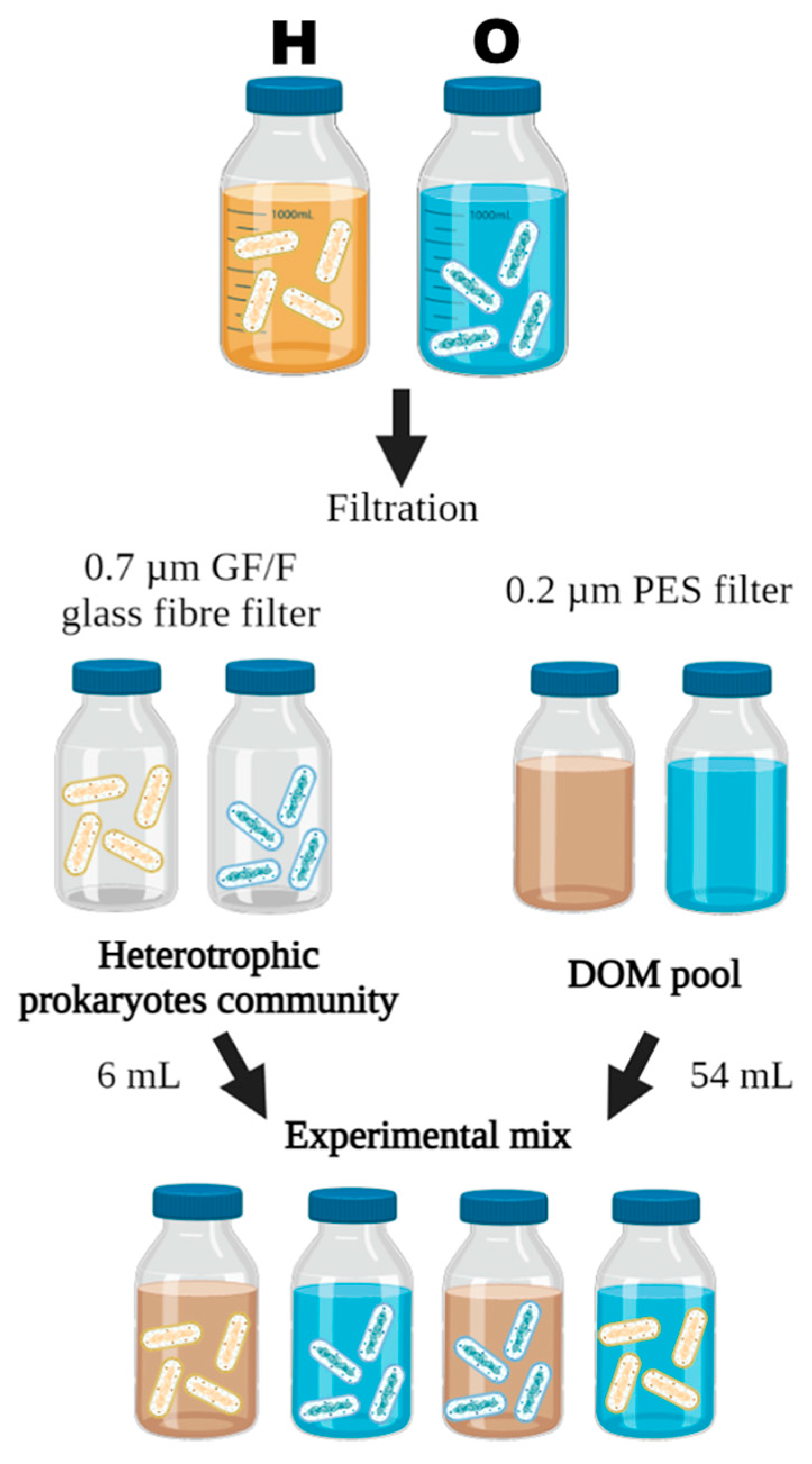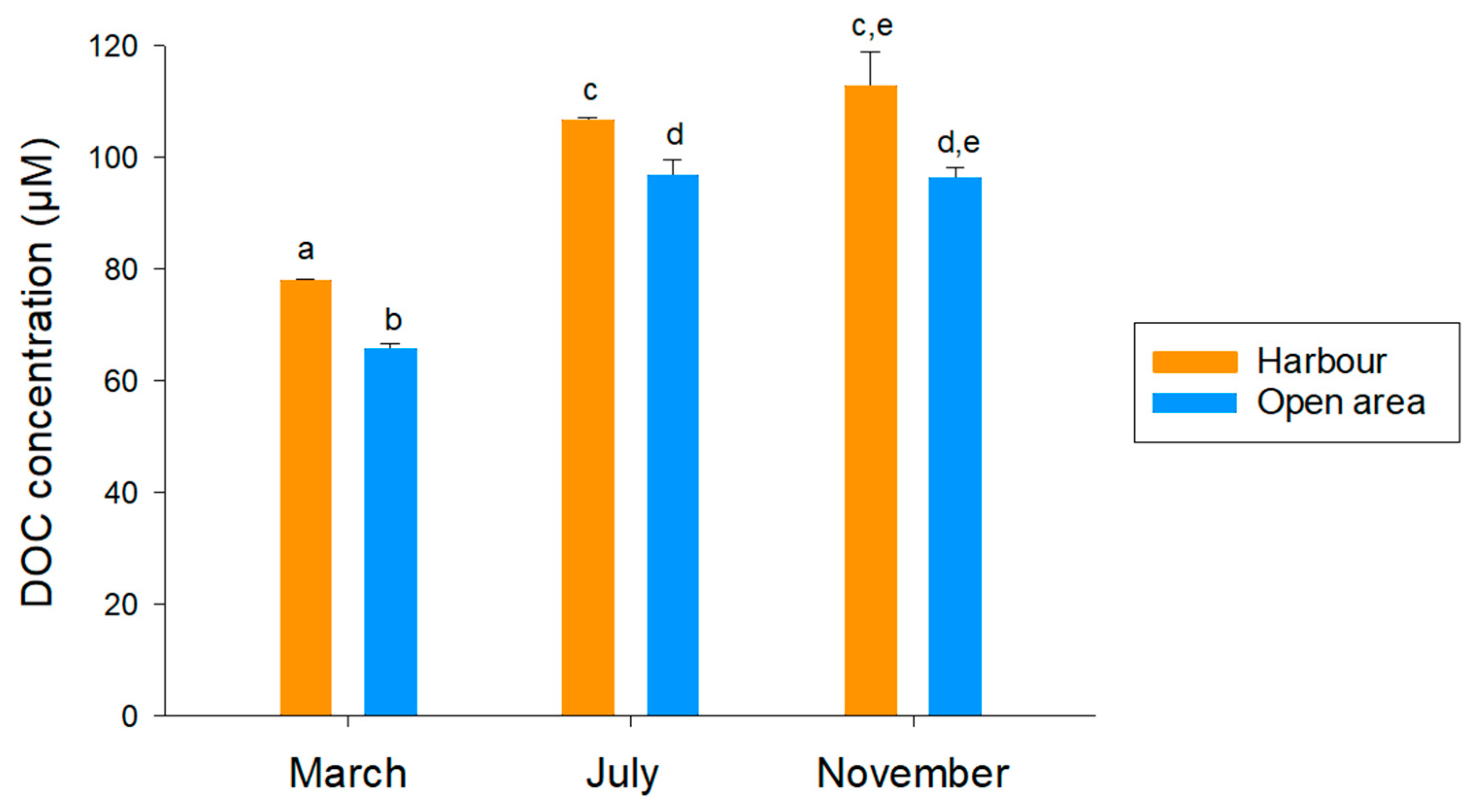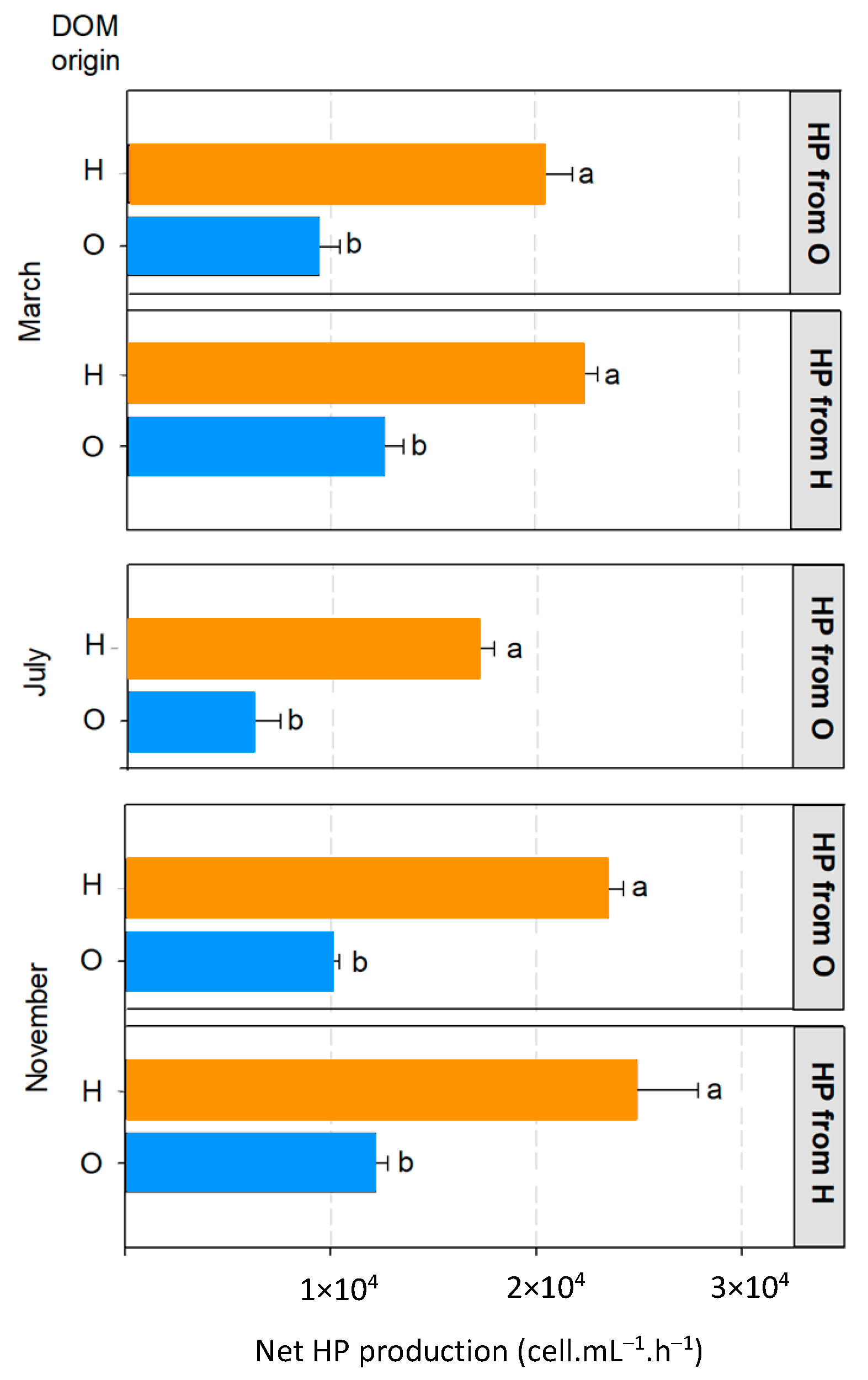An Effect-Based Method to Evaluate Spatio-Temporal Variations of Coastal Marine DOM Properties
Abstract
:1. Introduction
2. Materials and Methods
3. Results and Discussion
Author Contributions
Funding
Institutional Review Board Statement
Informed Consent Statement
Data Availability Statement
Acknowledgments
Conflicts of Interest
References
- Farrington, J. Overview and key recommendations. Marine organic geochemistry workshop, January 1990. Mar. Chem. 1992, 39, 5–9. [Google Scholar]
- Azam, F. Microbial control of oceanic carbon flux: The plot thickens. Science 1998, 280, 694–696. [Google Scholar] [CrossRef]
- Duclow, H.W.; Kirchman, D.L.; Anderson, T.R. Themagnitude of spring bacterial production in the NorthAtlantic Ocean. Limnol. Oceanogr. 2002, 47, 1684–1693. [Google Scholar] [CrossRef]
- Amon, R.M.W.; Benner, R. Linkages among the bioreactivity, chemical composition, and diagenetic state of marinedissolved organic matter. Limnol. Oceanogr. 2001, 46, 287–297. [Google Scholar] [CrossRef]
- Borum, J.; Sand-Jensen, K. Is total primary production in shallow coastal marine waters stimulated by nitrogen loading? Oikos 1996, 76, 406–410. [Google Scholar] [CrossRef]
- Cloern, J.E.; Foster, S.Q.; Kleckner, A.E. Phytoplankton primary production in the world’s estuarine-coastal ecosystems. Biogeosciences 2014, 11, 2477–2501. [Google Scholar] [CrossRef]
- Coclet, C.; Garnier, C.; Durrieu, G.; Omanovic, D.; D’Onofrio, S.; Le Poupon, C.; Mullot, J.U.; Briand, J.F.; Misson, B. Changes in Bacterioplankton Communities Resulting from Direct and Indirect Interactions with Trace Metal Gradients in an Urbanized Marine Coastal Area. Front. Microbiol. 2019, 10, 257. [Google Scholar] [CrossRef]
- Coclet, C.; Garnier, C.; Durrieu, G.; D’Onofrio, S.; Layglon, N.; Briand, J.F.; Misson, B. Impacts of copper and lead exposure on prokaryotic communities from contaminated contrasted coastal seawaters: The influence of previous metal exposure. FEMS Microbiol. Ecol. 2020, 96, fiaa048. [Google Scholar] [CrossRef]
- United Nations Environment Programme/Mediterranean Action Plan and Plan Bleu. State of the Environment and Development in the Mediterranean: Key Messages; United Nations Environment Programme: Nairobi, Kenya, 2020. [Google Scholar]
- Robarts, R.D. Incorporation of Radioactive Precursors into Macromolecules as Measures of Bacterial Growth: Problems and Pitfalls. In Molecular Approaches to the Study of the Ocean; Cooksey, K.E., Ed.; Springer: Dordrecht, The Nertherland, 1998. [Google Scholar] [CrossRef]
- Volk, C.; Renner, C.; Robert, C.; Joret, J.C. Comparison of two techniques for measuring biodegradable dissolved organic carbon in water. Environ. Technol. 1994, 15, 545–556. [Google Scholar] [CrossRef]
- Ammerman, J.W.; Fuhrman, J.A.; Hagström, A.; Azam, F. Bacterioplankton growth in seawater: I. Growth kinetics and cellular characteristics in seawater cultures. Mar. Ecol. Prog. Ser. 1984, 18, 31–39. [Google Scholar] [CrossRef]
- Layglon, N.; Misson, B.; Durieu, G.; Coclet, C.; D’Onofrio, S.; Dang, D.H.; François, D.; Mullot, J.U.; Mounier, S.; Lenoble, V.; et al. Long-term monitoring emphasizes impacts of the dredging on dissolved Cu and Pb contamination along with ultrplankton distribution and structure in Toulon Bay (NW Mediterranean Sea, France). Mar. Pollut. Bull. 2020, 156, 111196. [Google Scholar] [CrossRef] [PubMed]
- Paix, B.; Layglon, N.; Le Poupon, C.; D’Onofrio, S.; Misson, B.; Garnier, C.; Culioli, G.; Briand, J.F. Integration of spatio-temporal variations of surface metabolomes and epibacterial communities highlights the importance of copper stress as a major factor shaping host-microbiota interactions within a Mediterranean seaweed holobiont. Microbiome 2021, 9, 201. [Google Scholar] [CrossRef] [PubMed]
- Louis, Y.; Garnier, C.; Lenoble, V.; Mounier, S.; Cukrov, N.; Omanović, D.; Pižeta, I. Kinetic and equilibrium studies of copper-dissolved organic matter complexation in water column of the stratified Krka River estuary (Croatia). Mar. Chem. 2009, 114, 110–119. [Google Scholar] [CrossRef]
- Hansell, D.A. Dissolved Organic Carbon Reference Material Program. Eos Trans. Am. Geophys. Union 2005, 86, 318. [Google Scholar] [CrossRef]
- Grégori, G.; Citterio, S.; Ghiani, A.; Labra, M.; Sgorbati, S.; Brown, S.; Denis, M. Resolution of viable and membrane-compromised bacteria in freshwater and marine waters based on analytical flow cytometry and nucleic acid double staining. Appl. Environ. Microbiol. 2001, 67, 4662–4670. [Google Scholar] [CrossRef]
- Sachse, A.; Henrion, R.; Gelbrecht, J.; Steinberg, C.E.W. Classification of dissolved organic carbon (DOC) in river systems: Influence of catchment characteristics and autochthonous processes. Org. Geochem. 2005, 36, 923–935. [Google Scholar] [CrossRef]
- Wen, Z.; Song, K.; Shang, Y.; Lyu, L.; Tao, H.; Liu, G. Natural and anthropogenic impacts on the DOC characteristics in the Yellow River continuum. Environ. Pollut. 2021, 287, 117231. [Google Scholar] [CrossRef]
- Misson, B.; Garnier, C.; Lauga, B.; Dang, D.H.; Ghiglione, J.F.; Mullot, J.U.; Duran, R.; Pringault, O. Chemical multi-contamination drives benthic prokaryotic diversity in the anthropized Toulon Bay. Sci. Total Environ. 2016, 556, 319–329. [Google Scholar] [CrossRef]
- Wafo, E.; Abou, L.; Nicolay, A.; Boissery, P.; Garnier, C.; Portugal, H. Historical trends of polycyclic aromatic hydrocarbons (PAHs) in the sediments of Toulon Bay (South of France). Int. J. Environ. Monit. Anal. 2017, 5, 150–158. [Google Scholar] [CrossRef]
- Guigue, C.; Tedetti, M.; Dang, D.H.; Mullot, J.U.; Garnier, C.; Goutx, M. Remobilization of polycyclic aromatic hydrocarbons and organic matter in seawater during sediment resuspension experiments from a polluted coastal environment: Insights from Toulon Bay (France). Environ. Pollut. 2017, 229, 627–638. [Google Scholar] [CrossRef]
- Layglon, N.; Lenoble, V.; Longo, L.; D’Onofrio, S.; Mounier, S.; Mullot, J.U.; Sartori, D.; Omanovic, D.; Garnier, C.; Misson, B. Cd transfers during marine sediment resuspension over short and long-term period: Associated risk for coastal water quality. Mar. Pollut. Bull. 2022, 180, 113771. [Google Scholar] [CrossRef]
- Copin-Montégut, G.; Avril, B. Vertical distribution and temporal variation of dissolved organic carbon in the North-Western Mediterranean Sea. Deep Sea Res. Part I Oceanogr. Res. Pap. 1993, 40, 1963–1972. [Google Scholar] [CrossRef]
- Avril, B. DOC dynamics in the northwestern Mediterranean Sea (DYFAMED site). Deep Sea Res. Part II Top. Stud. Oceanogr. 2002, 49, 2163–2182. [Google Scholar] [CrossRef]
- Pujo-Pay, M.; Conan, P. Seasonal variability and export of dissolved organic nitrogen in the northwestern Mediterranean Sea. J. Geophys. Res. Ocean. 2003, 108, 3188. [Google Scholar] [CrossRef]
- Delpy, F.; Serranito, B.; Jamet, J.L.; Grégori, G.; Le Poupon, C.; Jamet, D. Pico-and nanophytoplankton dynamics in two coupled but contrasting coastal bays in the NW Mediterranean Sea (France). Estuaries Coasts 2018, 41, 2039–2055. [Google Scholar] [CrossRef]
- Silva, L.; Calleja, M.L.; Huete-Stauffer, T.M.; Ivetic, S.; Ansari, M.I.; Viegas, M.; Morán, X.A.G. Low abundances but high growth rates of coastal heterotrophic bacteria in the Red Sea. Front. Microbiol. 2019, 9, 3244. [Google Scholar] [CrossRef] [PubMed]




Disclaimer/Publisher’s Note: The statements, opinions and data contained in all publications are solely those of the individual author(s) and contributor(s) and not of MDPI and/or the editor(s). MDPI and/or the editor(s) disclaim responsibility for any injury to people or property resulting from any ideas, methods, instructions or products referred to in the content. |
© 2023 by the authors. Licensee MDPI, Basel, Switzerland. This article is an open access article distributed under the terms and conditions of the Creative Commons Attribution (CC BY) license (https://creativecommons.org/licenses/by/4.0/).
Share and Cite
Dignan, C.; Lenoble, V.; Pringault, O.; Misson, B. An Effect-Based Method to Evaluate Spatio-Temporal Variations of Coastal Marine DOM Properties. J. Mar. Sci. Eng. 2023, 11, 1841. https://doi.org/10.3390/jmse11101841
Dignan C, Lenoble V, Pringault O, Misson B. An Effect-Based Method to Evaluate Spatio-Temporal Variations of Coastal Marine DOM Properties. Journal of Marine Science and Engineering. 2023; 11(10):1841. https://doi.org/10.3390/jmse11101841
Chicago/Turabian StyleDignan, Clara, Véronique Lenoble, Olivier Pringault, and Benjamin Misson. 2023. "An Effect-Based Method to Evaluate Spatio-Temporal Variations of Coastal Marine DOM Properties" Journal of Marine Science and Engineering 11, no. 10: 1841. https://doi.org/10.3390/jmse11101841







